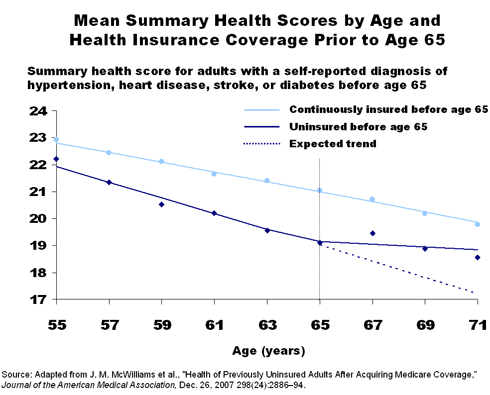In the Literature
Studies show that uninsured older adults (ages 50 to 64) receive fewer basic clinical services, are more likely to experience health declines, and die at younger ages than insured adults in the same age group. When these individuals enter the Medicare program at 65, they may do so with health complications that require more costly care than if they had been insured before age 65.
In "Use of Health Services by Previously Uninsured Medicare Beneficiaries" (New England Journal of Medicine, July 12, 2007), researchers at Harvard Medical School led by J. Michael McWilliams, M.D., compared the health care use and expenditures of beneficiaries who did and did not have insurance prior to entering Medicare. They found that, among beneficiaries with chronic conditions, the previously uninsured had significantly greater use of physician visits and hospitalization than did previously insured adults.
Legislation to allow older adults to buy into Medicare coverage before age 65 was introduced to Congress in 2005. This coverage may not only improve health outcomes but may also reduce health care use and Medicare expenditures by providing preventive care.
Tracking Long-Term Effects of Being Uninsured
The researchers used nationally representative, longitudinal data from the University of Michigan's Health and Retirement Study to examine the health care use and expenditures of 5,518 adults who were either privately insured or uninsured before entering Medicare. This method allowed for a direct assessment of the effect of insurance coverage before age 65 on adults' subsequent need for health services. All of the data were self-reported.
A high proportion of older adults lacked health insurance for some period. Of the 5,158 adults, 3,773 (73%) had continuous private coverage before Medicare, while 1,385 (27%) were uninsured for some time between ages 59 and 65. Older adults also had a high incidence of chronic conditions: more than half of the study cohort (57%) had been diagnosed with hypertension, diabetes, heart disease, or stroke before age 65. Uninsured older adults with chronic conditions are at high risk for costly—and preventable—health complications.
Previously Uninsured Use More Medicare Services
Among all adults surveyed, uninsured adults reported significantly fewer doctor visits and hospital stays than did insured adults before age 65 and slightly, but not significantly, more visits and admissions after age 65.
When they focused on the chronically ill population, however, the researchers discovered some striking results. Among adults with hypertension, diabetes, heart disease, or stroke diagnosed before age 65, previously uninsured adults reported significantly greater increases in the numbers of doctor visits and hospitalizations under Medicare than did previously insured adults. They also reported higher total medical expenditures. In analyses adjusted for supplemental and prescription drug coverage, previously uninsured adults with these conditions reported more doctor visits, more hospitalizations, and higher total medical expenditures from ages 65 to 72, compared with previously insured adults.
There were not significant differential increases in use of health services or costs found among the 2,207 adults without these conditions.
Extending Coverage Could Bring Long-Term Savings
"The longitudinal effects of being uninsured were concentrated among near-elderly adults with cardiovascular disease or diabetes," the authors note. "Suboptimal control of high blood pressure and glucose and cholesterol levels can cause life-threatening complications such as myocardial infarction or stroke and major chronic ailments such as kidney disease and congestive heart failure, thereby increasing the need for costly hospitalizations, ambulatory care, procedures, and medications."
These results suggest that providing health insurance coverage for uninsured adults in late middle age may improve their health outcomes and reduce their health care use and spending after age 65. Indeed, providing older adults with access to appropriate care to manage their conditions could help offset the costs of expanding coverage and produce long-term cost savings for the Medicare program.
As the U.S. population ages, and as private coverage become less affordable, the number of uninsured older adults may increase substantially. Providing insurance coverage for uninsured adults in late middle age may improve their health outcomes, reduce their health care use and spending between ages 65 and 72, and ultimately help to offset the costs of expanding coverage.
